2014-2015 Chalten Season
Because this blog post is so long, I’ve broken it up into chapters:
1) Introduction
2) Torre de la Medialuna and Rescues
3) Tomahawk and Aguja Cuatro Dedos
4) Piergiorgio Attempt
5) La Travesía del Oso Buda
6) Cerro Torre Southeast Ridge Attempt
7) Directa de la Mentira
8) Torre Egger Daytrip
9) Torre Traverse Daytrip Attempt
9) Torrisimo
1) Introduction
I’m far behind on updating my blog. Contrary to the popular myth that climbing in Patagonia involves tons of time spent waiting around and fighting boredom, my time in El Chaltén always feels very busy. Despite plenty of bad weather in the first half of the Chalten season, keeping very busy around town, and perhaps not managing my time well enough, kept me from updating my blog after my first couple climbs in the mountains. Then, when the weather gods changed their disposition dramatically in mid January, I lost all chance – The windows of good weather starting coming so frequently that there was barely enough time to replace lost calories and repack equipment between trips to the mountains.
This past season in Chalten, my twelfth trip to these mountains, was my most successful yet, and also the most successful climbing trip of my life. Although I had very good seasons in 2011-2012 and 2012-2013, the only other season that truly equals this one in terms of significance in my progression as a climber was 2007-2008. That was the year that Rolo Garibotti invited me to try the Torre Traverse with him, an opportunity that was pivotal in my life. Rolo gave me the opportunity to accomplish an amazing climb with him, but much more importantly he played a huge role in my development as an alpinist. I of course learned a lot of technique and tricks from Rolo, but it was his general influence on me that had a much farther-reaching impact. I’ve had the opportunity to climb with many very talented climbers, but climbing with Rolo at his prime exposed me to a level of dedication and skill that I had never witnessed before. It was a humongous inspiration to me, and also provided a clear concept of how I needed to improve as a climber.
I’m pleased to say that every year for the past twenty years I’ve become a more skilled climber. However, my improvements have always been gradual and incremental. It’s not like I was a drastically stronger climber this season than I was last year, a season in which I accomplished relatively little by comparison. The truth is that of course you have to be experienced, motivated, fit and skilled to rise to the occasion, but in the end success is usually dependent on three factors largely out of one’s control: Having good conditions, having good weather, and having a good partner available and motivated. And, of course, the key is for all three of those factors to come together at the same moment. The reason I’ve had such a successful season in Patagonia this year is because these three factors came together, not just once or twice, but several times in a row.
The third factor, having a good partner, is often the most tricky. When it comes to serious and difficult alpine climbing, I don’t have a lot of patience for incompetent, unsafe or unmotivated partners, and thus am usually very picky about who I climb with. However, the pool of potential equal partners gets smaller and smaller as your skill level increases, and in the past few years I think I’ve been too picky, turned too often to soloing, and have limited myself as a result. As this Patagonia season was approaching and beginning, I reminded myself that you often have to go out on a limb and take chances to reap rewards. I went on three “blind dates” this season – partnering up with climbers who I had hardly climbed with before, and all of whom are strong technical climbers but had drastically less alpine climbing experience than me. I’m happy to say that all three “blind dates” turned out wonderfully. The advantage of extensive experience is usually in strategy and decision-making rather than the pitches themselves, and each of my blind dates were gracious enough to let me take the reigns on strategy and decision-making, thus largely eliminating any limitation from their lack of experience in big mountains. All three of them are adaptable climbers and fast learners, which was also critical to our success. More important than anything else though, all three of my blind dates were 100% motivated, and motivation is the absolute most important skill an alpinist can have.
2) Torre de la Medialuna and Rescues
For the first three weeks of my Chalten season I was climbing with my girlfriend, Sarah Hart. She has much less alpine climbing experience than I, but is a strong climber and very motivated. When Sarah and I team up in Chalten we often end up climbing in the mountains during periods of marginal weather when no one else is even trying. However, when it’s properly bad there isn’t much to try even for a very motivated team, and we only had one chance in those three weeks to go climbing in the mountains.
A good window showed up for December 13-14, and we hiked into Niponino on the 12th, planning to attempt a big route on Aguja Bifida, one of the most under-appreciated mountains in the range. Unfortunately our plans get derailed the night of the 12th when, just before going to sleep, we heard faint cries for help from upvalley. We hiked a short ways upvalley from Niponino, and soon came across two young and extremely inexperienced Italian climbers who had left town five days earlier. Despite having never been to Patagonia before, and despite having never even climbed in the Alps, they had gone directly to attempt the west face of Cerro Torre, during a period of bad weather in which I had advised them not to climb in the mountains at all. They only made it halfway to the base of Cerro Torre’s west face, but in the process of getting halfway there and retreating they had gotten completely worked, and then taken a tumble on the glacier. They described their injuries as each having several broken bones, although it turned out later that one of them had a hairline fracture in one bone and the other climber was completely uninjured. Sarah began attending to the two of them while I went back to Niponino to rally more climbers to help. Sarah and I, along with two Argentine climbers, completely cancelled our climbing plans for the next day, so that we could help carry the injured climber down-glacier on a litter (along with a large crew of rescuers who came up from town). Several other teams went forward with their climbing plans the next day, but spent most of the night helping in the rescue effort rather than sleeping and resting for their objectives.
I’m not writing about this incident to complain that our climbing plans were derailed. Of course if climbers are in need of real help it is the duty of others to lend a hand. I’m writing about this incident as a note of caution for others. Yes, nearly all of us take risks in the mountains that might result in an accident. Many experienced and prudent climbers require a rescue eventually when the odds stack up against him/her. Climbing a little bit beyond your previous experiences is part of pushing yourself and developing greater experience. However, everything is a balance, and it doesn’t work to just throw yourself at an objective that is not merely a bit beyond your abilities and experience, but drastically beyond your experience and abilities. All of us make poor decisions sometimes, and these two young Italian climbers were gracious and thankful for everyone’s help, but I hope they have learned from their mistakes. An example of another recent rescue in the Chalten massif that was at the completely other end of the spectrum, was Tomas Franchini and Francesco Salvaterra on the Supercanaleta in December 2013. Tomas and Francesco are also young, Italian climbers, but with extensive experience and climbing well within their abilities. Tomas broke a hold high in the Supercanaleta and took a big lead fall (as can happen to anyone), breaking his ankle in the process. They rappelled the roughly 1,200m to the base of the mountain, Tomas limped all the way to Piedra del Fraile, and only there asked for a ride on an ATV out to the road.
Anyways, after the rescue effort on the 13th, Sarah and I had one day of good weather left to use. We were a bit tired from the nighttime rescue operation and ensuing litter-carrying, so decided to head for a mellow objective: Torre de la Medialuna. It’s a spire that is relatively small and un-committing by Patagonian standards, but the classic route, Rubio y Azul (established solo by Ermanno Salvaterra) has some outstanding climbing, and I’d never done it. I don’t play the free-climbing game very often in the mountains, because I usually prefer to throw myself at objectives big and serious enough that moving as quickly and efficiently as possible is critical to success. However, of course I enjoy free-climbing, so in the rare instance that I was on a Patagonian objective without being very pressed for time, I figured I’d try to avoid any aid moves. A difficult section on the fourth pitch was running with water, and being just above a big ledge I didn’t want to risk a fall, and pulled on a few pieces. I was happy to free-climb the rest of the route though, especially the crux 6c fist crack, which was also running with water. After the crux pitch, two more pitches brought me to the summit, with an easy but very exciting step-across move to attain the summit itself.
On the same day that we were climbing Medialuna, there was another rescue happening on the Glaciar Fitz Roy Norte. One member of a two-man German team fell into a crevasse, and his partner did not know crevasse rescue techniques. Two Norwegian climbers happened to be nearby, and fortunately pulled the injured German climber from the crevasse without incident, but not before a helicopter had been called. The helicopter arrived and was attempting to land at the same time that the Norwegians were extricating the German from the crevasse. A sudden gust of wind caused the small helicopter to crash, and tragically the pilot died in the crash.















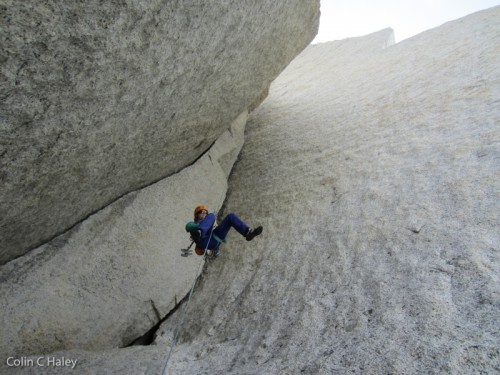
3) Tomahawk and Aguja Cuatro Dedos
For two weeks in late December and early January I teamed up with a young Norwegian climber, Martin Olslund. Our partnership was not planned in advance, but put together on the spot in El Chalten, at the recommendation of our mutual friend, Marius Olsen. Martin does not have a lot of alpine climbing experience, but is currently one of the strongest traditional climbers in Norway, both on rock and ice. He has also done a lot of big-wall climbing, which in Norway is generally much more similar in character to alpine climbing than in the US. Despite being a strong athlete, Martin is very kind, quiet, thoughtful and polite, and in that regard reminded me a lot of my friend Bjørn-Eivind Årtun, one of my best-ever climbing partners, who sadly died in an accident on Kjerag (a bigwall in southwest Norway) in 2012.
Martin and I only had one opportunity to climb together in the mountains. On December 31st we hiked in to Niponino with somewhat amorphous plans. Often when the weather and conditions are particularly difficult to gauge I hike into the mountains with several objectives at the front of my mind, and wait until observing conditions up close to make a final decision. On New Year’s Eve at Niponino we decided upon Tomahawk, an awesome ice chimney route on Aguja Standhardt which saw its first complete ascent in 1997 by Bruno Sourzac and Laurence Monnoyeur. Since I had already climbed Exocet a few times before, we divided our blocks for maximum enjoyment – I would lead most of Tomahawk itself up to the snow-fields at mid-height (this portion was first climbed by Conrad Anker and Steve Gerberding in 1994), and then Martin would lead most of the classic Exocet ice chimney to the summit.
On the first day of 2015 we got a very early start – Many attempts on Tomahawk have been thwarted by its east-facing nature, arriving at the base of the Exocet chimney too late, and finding it pouring with water. I led the first couple of uninspiring mixed pitches in the dark, and started up Tomahawk’s “money” pitch just before first light. Although the topos would suggest otherwise, Tomahawk is mostly a one-pitch wonder, with most of the ice steps above being short steps of AI3-4. Nonetheless, the one pitch is so spectacular that the route as a whole is well worthwhile – a full 60+ meters of sustained AI5-6, in a chimney with golden granite (and the occasional bomber cam) on the opposite wall.
After the “money” pitch we simul-climbed most of the terrain up to the base of Exocet. I was pulling hard on the ropes, and I think that Martin might’ve thought me being a bit too harshly focused on speed, unaware at the time of all the parties who had been thwarted by arriving to Exocet too late. Climbing in Patagonia is more speed-dependent than anywhere else I know, as arriving to the top of a mountain one hour earlier or later often can mean the difference between success and failure. In the end I’d say that we did climb Tomahawk too slowly, but fortunately some partial cloud cover saved us. Martin did a great job of leading the Exocet chimney quickly, and we got through it in the nick of time, although I got soaked while following the last pitch. The last pitches to the summit went quickly and easily, and before too long we were beginning the relatively straightforward descent of Exocet and Desarmada. Tomahawk is definitely one of the coolest ice climbs I’ve done anywhere, and I highly recommend it when conditions are cold enough. Although there have been several strong attempts since Bruno and Laurence’s first ascent (including one to the top of the Exocet chimney by Oriol Baro and partner), I was surprised afterwards to learn that Martin and my ascent was likely the second complete ascent.
The day after climbing Tomahawk, Martin and I slept and recovered in Niponino. One more half-day of good weather was forecasted for January 3rd, so we spent another night at Niponino with the hope of squeezing in one more climb. On the third we got an early start, and headed for an objective which I thought was just barely small enough to fit into our time constraints: the “normal” route (I think we made the third ascent) on Aguja Cuatro Dedos, established in 1997 by Rab Carrington and Alan Rouse, during their very impressive new-routing spree.
With a newfound deeper appreciation for the importance of speed in Patagonian climbing, Martin raced up the approach, and within a few hours of departing Niponino we started soloing up the north ridge of Aguja Cuatro Dedos. At the first difficult step we got out the ropes, made one very long simul-climbing pitch, and then two belayed pitches to the summit. We arrived at the summit just in time to soak in some spectacular views, and within five minutes the clouds had obliterated our visibility of any terrain further than a couple hundred meters away. In a trend that was to continue for the remainder of my season, we had fully maximized the weather window. The descent went smoothly, we packed up our things at Niponino, and ran most of the way back to El Chalten to finish up a very satisfying few days.

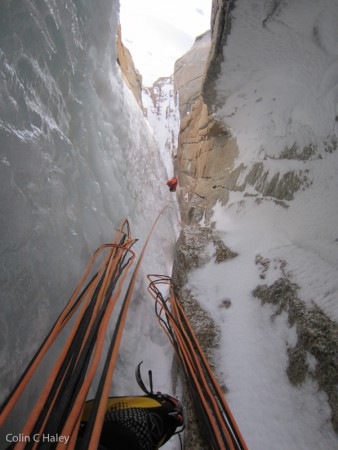
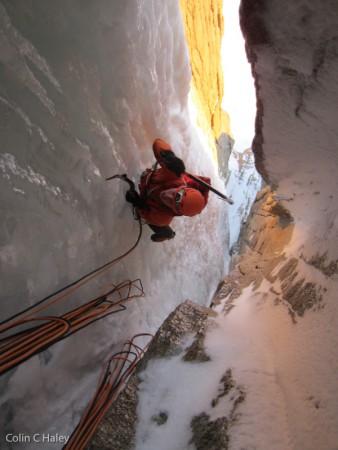


































4) Piergiorgio Attempt
In mid January another short weather window appeared, although preceded by a lot of snowfall. While no one else bothered hiking into the Torre Valley, Sarah and I made the snowy approach, figuring that ice and mixed routes should still be climbable. On January 14th we made a brief attempt on the east face of Cerro Piergiorgio, but Sarah experienced a relapse of a stomach illness that she had picked up the week before, and we bailed just a couple ropelengths above the bergschrund. It did make for some beautiful morning views, however, and Sarah got in some good practice on snow and ice climbing, which is not her background and therefore exciting to see her progress in.










5) La Travesía del Oso Buda
For a few months prior, I had three weeks from January 15 to February 7 blocked off to climb with Marc-André Leclerc. Marc is the Canadian version of Martin – quite young, but already a very talented and accomplished technical climber. For several years Marc has been making an impression in Squamish with his high-level rock-climbing skills. He’s also a capable waterfall climber, and although his experience in big mountains is limited, he is very rapidly changing that. Marc and I had only ever climbed together for a few pitches on The Chief, and although we had hoped to try alpine climbing together in BC in the fall, we never found the time. It was clear though that Marc had all the ingredients, and a lot of the most important ingredient (motivation), and thus began my second blind date of the season. Marc arrived in Chalten just before the longest window of the season, and although it would’ve been great to do a warm-up climb together, the climate dictated that we head straight for my multi-year highest-priority project: the reverse traverse.
It’s an idea that Jim Donini came up with in the mid ’80’s (as I only recently learned) but I first heard the idea from the Norwegian climber Bjørn-Eivind Årtun: A Torre Traverse in the opposite direction, starting with Cerro Torre and finishing with Aguja Standhardt. Bjørn-Eivind and I teamed up for very successful trips to Alaska in 2009 and 2010, but it wasn’t until the 2011-2012 Patagonia season that we finally planned to climb together in the Chalten Massif, specifically for the reverse traverse. We talked strategy, we talked equipment, and we even dreamed of starting with Los Tiempos Perdidos. We talked about the two missing segments: a direct ice route on the south face of Torre Egger (to avoid the time-consuming aid of the American route, and also because the ice line simply looked fantastic), and the south face of Aguja Standhardt. We decided that in shorter windows we would tackle those missing segments, and in a big window we would go for the whole traverse, even if the missing segments hadn’t been investigated yet. Our differences in patience and risk tolerance had been a source of tension during our trips to Alaska, but came to a head in the summer of 2011 on our brief trip to the Karakorum together, and sadly we had somewhat of a falling out. We called off our partnership for the 2011-2012 Patagonia season, and found other partners.
In the 2011-2012 Patagonia season, both of the missing segments of the reverse traverse came together. In December I teamed up with Argentine climber Jorge Ackermann, and together we completed the often-tried south face of Aguja Standhardt, naming the route El Caracol. Three weeks later, Bjørn-Eivind and Ole Lied completed the first ascent of the ice line on the south face of Torre Egger, creating one of the most amazing ice climbs on Earth, and naming it Venas Azules. In late January Bjørn-Eivind teamed up with a longtime friend of mine from Seattle, Chad Kellogg, for the first real attempt on the reverse traverse. The weather was not ideal and they were ill-prepared in terms of rest and equipment (this being in the immediate wake of Carlyle Norman’s death and attempted rescue efforts), and thus never made it onto Torre Egger, but in their attempt they did make the first complete descent of Cerro Torre’s north face, which is daunting in and of itself. Bjørn-Eivind and I had been slowly repairing our friendship and partnership during the 2011-2012 Patagonia Season, and by the time I got home in early February I imagined again that we would eventually try the reverse traverse together. That idea was broken by the news from my friend Nils: Just a couple weeks after returning from Patagonia, Bjørn-Eivind died from Rockfall on Kjerag, a bigwall in southwest Norway. Two years later, in February 2014, Chad Kellogg was killed by rockfall while descending Cerro Chaltén’s Supercanaleta.
My first attempt on the reverse traverse was over Christmas 2012 with Jon Walsh. We successfully climbed the Ragni route on Cerro Torre and descended the north face (discovering a couple anchors left by Bjørn-Eivind and Chad), but made it only halfway up Venas Azules before the weather window abruptly ended in storm. Thus, when Marc-André arrived in Patagonia in mid January, I was very excited to head for the reverse traverse – It had been my biggest climbing project anywhere in the world for a few years already, I had already put in a good try, and it also represented to me unfinished business of two friends and climbing partners I had lost.
Marc and I hiked into Niponino on January 17th. It rained all night, and we departed Niponino only a couple hours after the drops stopped falling, with the mountains still in cloud. Our approach day on the 18th was up to the Standhardt Col, down the other side to the Circo de las Altares, then up Filo Rosso to a bivouac just below the Col de Esperanza. Marc had been on Aconcagua before coming to Chalten, and while there had contracted a nasty gastrointestinal illness and been airlifted off the mountain. His energy levels hadn’t rebounded completely since getting sick, and while slogging up Filo Rosso Marc often had a difficult time keeping up, even when I was breaking trail in soft snow. It was a disconcerting start to a massive alpine climb, but we figured that gorging on food at the bivouac would help, and most of the rest of the adventure would be less dependent on fitness and more on technical climbing ability.
On January 19th we started up Cerro Torre’s Ragni route before first light, but after the two other parties climbing it that day. Despite our packs laden with gear for 3 days, we passed the two parties below the Elmo by simul-soloing and simul-climbing the low-angle ice. At the base of the first 5th-class pitch, the Elmo, Marc racked up. Like with Jon Walsh in 2012, I had offered Marc the opportunity to lead most of the Ragni route, since I had already climbed it a few times. Although Marc had climbed plenty of pitches of steep ice, he was totally unfamiliar with rime climbing, and as he started up the Elmo this became apparent as he slowed down considerably. One of the teams we had passed, renowned Swiss alpinist Simon Anthamatten and his girlfriend, Fabienne Götzenberger, became understandably impatient while Marc was leading the Elmo and eventually started up an alternate line. I asked Marc if he would mind if I lead, he said sure, and I took us to the top of the Headwall pitch. Above the headwall are the last three mushroom pitches, the first two of which are very easy, and I offered Marc the lead again. While Marc was leading the first mushroom pitch Simon passed us again, and so above I resumed leading. To be fair though, it’s not like Marc was leading particularly slowly. In fact, he was certainly still leading faster than the average party on the Ragni route (Simon is one of the world’s best alpinists, and climbs very fast), but for our goal it was important for the Ragni route to be nothing more than a quick warm up.
We reached the summit of Cerro Torre for my sixth time and Marc’s first at 11:50am. We rappelled back down the top three mushroom pitches of the Ragni route to the point where El Arca de los Vientos joins in, and took a break here to wait for the north face to go into shade. Sleep is a precious commodity on multi-day climbs in Patagonia, so while we were waiting we pitched the tent and took a nap. Around 6pm we buried a stuff-sack full of snow in the mushroom and started rappelling down the north face. The descent went as smoothly as one could possibly hope for. I found every one of the anchors that I had left two years earlier, and we didn’t get a single rope stuck. By 10pm we were settled into our tent, on a platform of chopped snow at the base of Cerro Torre’s north face, one pitch above the Col de la Mentira.
On January 20th we rappelled one pitch down to the Col de la Mentira, and started up Venas Azules around 8:15am. I led the first three pitches, the first two of which are relatively easy mixed climbing, and the third which is one of the most awesome ice pitches I know of anywhere. Marc took the lead at the base of the fourth pitch, a bit of AI4 leading into a spectacular A1 corner, with blobs or rime plastered on the walls to the side. This was Marc’s first hard lead of the climb, and his first hard lead in the mountains since getting sick on Aconcagua, and I could tell he was still warming up. By the time he yelled off belay an hour and forty-five minutes had passed – a pace which we couldn’t afford to stay on. I jugged up to his belay, and trying as hard as I could not to sound like a jerk, I had to let him know how long it had taken, since often while leading it is easy to lose track of time. Either my comment got him on track, or he simply needed one pitch to warm-up, because he took the rope up pitch five, a steep ice groove, at a much improved pace.
Marc headed quickly up the blue ice of the sixth pitch, and then started to slow down where it turned to rime. He was well warmed-up at this point though, and clearly had gotten the hang of rime climbing – it simply was steep, full-on rime climbing, that is slow for anyone. Time started to slip away as Marc hacked away at the rime and inched his way upwards. Suddenly I realized we were making a big mistake. For years I had already theorized about the possibility of starting up the first pitches of Venas Azules and then traversing on a ledge system to join the upper pitches of the American route (Torre Egger’s first ascent route), simply because it looked to me like the line of least resistance. Before Marc and I started our climb we even talked about this possibility, but while jugging the previous two pitches I was fully in “follower’s mode” – simply jug as fast as you can, hand over the rack, and put the leader on belay. While jugging I had neglected to realize that the upper portion of Venas Azules was noticeably more rimed up than when Jon Walsh and I had tried it, which already was much more rimed than during Bjørn-Eivind and Ole’s first ascent. I called my thoughts up to Marc and he easily agreed, as it looked like he had a very long section of vertical rime to deal with. Marc made a V-thread and lowered off, coincidentally at almost the exact same highpoint on Venas Azules as when Jon Walsh and I had been stormed off in 2012.
We rappelled one pitch down, to the ledge system that I thought would join us with the American route. I was quite stressed about time – Between Marc’s slow lead on the fourth pitch and my error in not realizing soon enough that we shouldn’t continue on Venas Azules, we had lost a few hours. We had originally hoped to make our next bivouac on the summit mushrooms of Punta Herron, and it was becoming obvious that it wouldn’t happen. I rushed off across the traverse, and led the upper half of the American route to the summit. There were a few tricky bits, but mostly it was surprisingly moderate. We reached the summit of Torre Egger at last light, and made our third bivouac just a few meters below, which at least was much more comfortable than any spots on Punta Herron would’ve been.
The 21st was our fourth pre-dawn wake up, and the alarm felt harsh, but we knew had no time to lose. We rappelled off of Torre Egger’s summit mushroom from another deadman anchor, and made our way down the Huber-Schnarf route more quickly and easily than expected. Aside from a couple moves of M5ish climbing, the south side of Punta Herron was short, quick and easy – mostly a respite from the adventure rappelling. As we rappelled down Spigolo dei Bimbi, on the north ridge of Punta Herron, the wind began to pick up and blow our ropes around. On the second-to-last rappel we finally got a rope stuck, and Marc did a great job of climbing up to free it.
We arrived at the Col dei Sogni at noon. It was exciting to be at the base of our last mountain, but a fair amount of uncertainty remained. El Caracol traverses into the south face of Standhardt from the side. The first section of terrain above the col had never been climbed, and I had always assumed it would be the crux of the reverse traverse. The south face of Standhardt is the only section of the entire reverse traverse where one can make use of rock shoes, and to save weight we had brought only Marc’s, since rock climbing is much more of his forté than mine. Marc led four pitches from the col up to join El Caracol, and one more once we had joined El Caracol. The terrain turned out to be much more benign than I had always feared, but was certainly not cruiser. Marc seemed to have become faster and more efficient each day of our climb, and on this block I felt that he had finally found his groove, and was fully utilizing the high-level technical skills that he has honed over years back home.
I took us up the last block, as the last three pitches of El Caracol were crampon terrain once again – two moderate mixed pitches, and then one last fight. The last pitch of El Caracol is perhaps the most involved pitch on all of the reverse traverse, with some tricky mixed climbing to start, and then a long section of slightly overhanging thin aid-climbing, complicated by the fact that it is plastered in thick rime ice, which must be hacked off for each placement. For the first time in a few days I finally relaxed and took my time, as we were so close to our goal that I knew now we would stick it out and make it. I fixed the rope just before putting on my headlamp, having easily taken as long as Marc had on the fourth pitch of Venas. But we were done! When Marc arrived at the belay I quickly scampered up the Standhardt summit mushroom, which is the easiest of the Torres, and at 11:10pm we were on top. We spent the night rappelling Exocet and Desarmada. After four days of nearly perfect weather, the wind gusts finally started to get violent on our last three rappels. We slogged down the glacier and finally fell asleep at Niponino.
The reverse traverse was for me, to at least some degree, what the Torre Traverse was for Rolo in 2008. It was the culmination of years of planning, and years of developing myself as a climber. I finally got to play the role that Rolo had in 2008; doing most of the leading and masterminding the strategy. Marc was a superb partner, and was gracious enough to not let his ego ever interfere with team efficiency. Marc’s role in the reverse traverse was similar to mine on the 2008 Torre Traverse, with fewer leads but still very important leads. The major difference is that on the 2008 Torre Traverse I was on my fourth Patagonian season and already had a lot of experience in the Chalten Massif. Aside from a small route on El Mocho, the reverse traverse was Marc’s first climb in Patagonia, which is rather incredible. His lack of prior experience was certainly apparent at first, but he is a fast learner and adaptable climber. In the span of one three-day climb he developed from a Patagonian newcomer to an efficient machine on these mountains. Nothing shows how quickly he developed a sense for these spires more than his jaw-dropping solo of the Cerro Torre’s Corkscrew route later in the season.
We named our traverse La Travesía del Oso Buda in remembrance of Bjørn-Eivind and Chad. In Norwegian “bjørn” means bear, and bear in Spanish is “oso.” Chad was buddhist, and with his mellowed-out demeanor and usual grin, reminded me of a Buddha himself. I wish I could share our success with them.
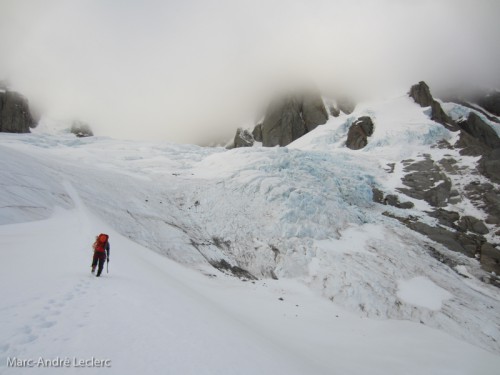
















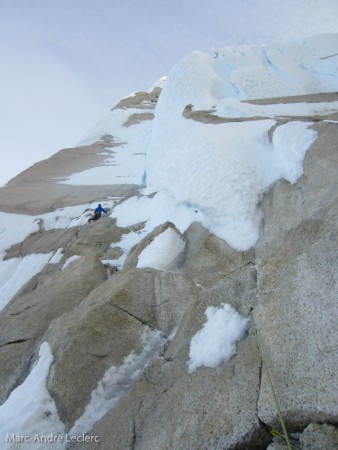



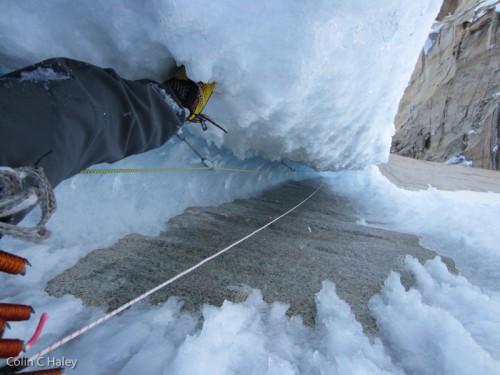








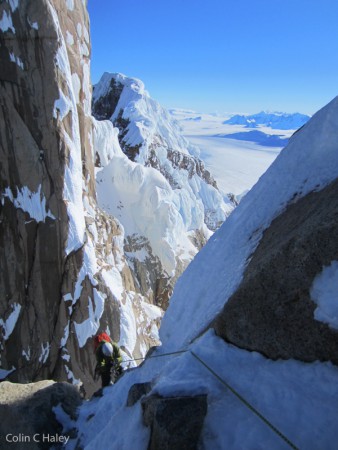




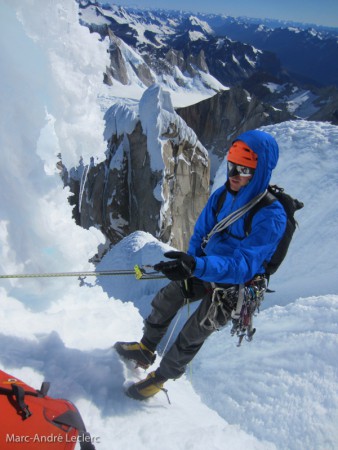





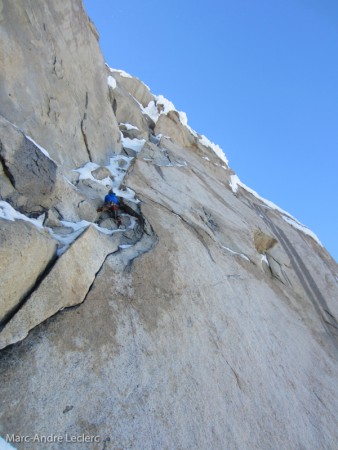


6) Cerro Torre Southeast Ridge Attempt
Marc and I had only three rest days in town before the weather forecast ushered us back into the Torre Valley on the afternoon of January 26. We thought that all the good weather we had experienced during the reverse traverse had cleaned the mountains enough to make a “fair means” ascent of Cerro Torre’s Southeast Ridge a good option. I had made two attempts on this objective in early 2011, the year before Hayden Kennedy and Jason Kruk’s success. Since their ascent, two other teams had also succeeded (David Lama and Peter Ortner, during Lama’s free ascent just a few days after Hayden and Jason, and hardcore Slovenians Luka Krajnc and Tadej Kriselj in 2013). We slept in at Niponino on the 27th, and took a leisurely day to hike up past the Norwegos bivouac, and pitch our tent on the glacier at the base of Cerro Torre’s east face. All of the previous “fair means” ascents had bivied somewhere on the route, but I was confident that the climb could be done just as easily as a daytrip.
It was windy and snowing for most of the night, which made us quite unsure about heading up, but we figured we might as well try, and started up at roughly midnight. We simul-soloed most of the way up to the Col de Patiencia, belaying just two short pitches. Our first lead block was from the Col de Patiencia up to the Salvaterra variation, and I took this section since I already knew it well and could easily manage the route-finding in the dark. It was clear quite quickly that conditions on the route were not nearly as good as my previous attempts in 2011, nor during my ascent of the Corkscrew Route with Chad Kellogg in 2013. On those occasions it was possible to put rock shoes on at the Col de Patiencia and leave them on until the ice towers. This time there was enough snow on the ridge that I had to change between rock shoes and boots with crampons several times leading up to the Salvaterra variation. In addition, the snowfall overnight had dusted snow on many of the holds, and it was difficult to keep my fingers from going numb on the first few pitches.
Marc took over the lead for the Salvaterra Variation. These are also pitches that I had led on previous occasions and knew quite well, but the route-finding is so straightforward in this section that it makes no difference. After the Salvaterra Variation I took us through the ice towers and up Josh Wharton’s ice chimney to the base of the headwall. The headwall is comprised of tricky face climbing and bits of aid, on just under-vertical rock with funky pro. It’s exactly the sort of terrain where Marc excels, so we planned for him to lead these last 5-6 pitches to the summit. The first headwall pitch went quickly and easily, and soon Marc was starting up the second pitch, a flaky 6c dihedral. The less-than-ideal conditions which we’d been dealing with up to here were more of an issue on harder climbing, and Marc ground to a halt about 15 meters up the pitch. The cracks were choked with ice, making both the protection and the climbing quite difficult. Marc asked me if I wanted to try, but since this sort of terrain is precisely his forté I doubted I would fair any better, and we retreated. The descent went smoothly, and the next day we were hiking out from the Torre Valley once again. It was a bit of a bummer to not succeed, but conditions are of course a very important factor, and I felt that we put in a good effort and climbed quite efficiently up to our highpoint.










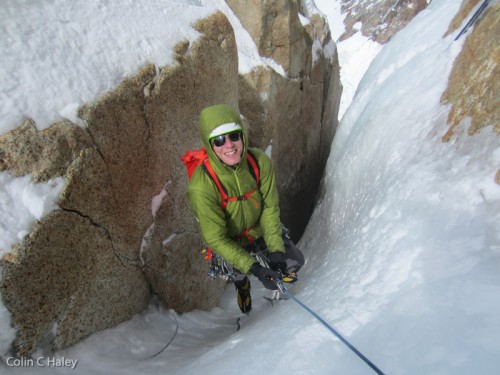






7) Directa de la Mentira
Marc and I got out to town from our Southeast Ridge attempt on the evening of January 29. As usual, I checked the weather forecast as soon as I’d taken my shoes off, and knew straightaway that we’d have a quick turnaround in town. We spent just two nights and one whole day in town, and on the afternoon of January 31 we were hiking back up to Niponino, with our sights set on another longstanding project of mine.
During my two descents of Cerro Torre’s north face (once during the reverse traverse attempt in 2012, and once during the successful reverse traverse), I had been amazed by the quantity and quality of crack systems that rise straight out of the Col de la Mentira (my name for the col between Cerro Torre and Torre Egger). The only established route that had climbed Cerro Torre from this side, El Arca de los Vientos, traverses onto the northwest face from the col, and cuts back onto the north face proper about halfway between the col and the top of the north face (the junction with the upper west ridge). Having rappelled twice directly down the direct terrain that El Arca avoids, I knew that with the right conditions it would make an awesome direct variation. I wanted to try it badly in February 2013, when conditions on the north face of Cerro Torre were better than any other time I’ve seen, but didn’t have a partner for such a project available. Conditions when Marc and I hiked in certainly weren’t as good as February 2013, but I felt confident they were at least good enough.
On February 1st we had a leisurely day hiking from Niponino up to the base of Cerro Torre’s east face, and pitched our tent on the same platform that we chopped out a few days earlier before trying the Southeast Ridge. We had hoped that sunny weather would clean off the rime that had formed on Cerro Torre during the previous couple days, but the day remained cloudy and cool. Like déja vu, it once again was windy and snowy during the night before starting. Brewing up some warm water before departing, we were dismayed to find that our isobutane-propane canister had a faulty valve. It’s common among gas canisters bought in Argentina, and I had been in too much of a rush to remember to test it. Our climb could’ve ended right then, but fortunately Marc’s pocketknife was kept on a small lanyard of ball-and-socket chain, and one of these small metal balls was just the right size to jam into the valve. Phew.
We were finally climbing by about 6am. I took the first block of about six pitches that climbs a big dihedral system to reach a prominent triangular snowfield on Cerro Torre’s lower east face. Conditions were tricky, and one pitch that would’ve been only moderately difficult was pretty full-on due to a veneer of verglas. As the sun began to hit the east face, the recent rime accumulations began to peel off and rain down on us. Soon enough we were climbing in a fairly nonstop barrage of grape-to-golfball sized rime chunks. It was a bit painful, but more importantly had us wondering if something big and dangerous might fall down. I looked far to the left and saw Elio Orlandi jugging his ropes, working on his longstanding project on the left side of the east face. Elio has spent as much time on Cerro Torre’s east face as anyone, so I figured if he thought it was safe enough then it probably was. Safe or not, the barrage of rime chunks would continue pretty much nonstop for the entirety of our two-day climb.
At the top of the triangular snowfield we crossed paths with badass Slovenians Luka Lindič, Luka Krajnc and Tadej Krišelj. They had started up several hours before us, hoping to try a new line on the east face, but were dissuaded by the falling ice chunks. Marc led the next block of about five pitches, up 5.10 slabs above the triangular snowfield. He got off route at one point, but we were able to correct it without losing much time. Above the slabs is a long section of easier climbing, mostly 4th class with occasional 5.7-5.9sh bits, leading up to the Col de la Mentira. I led this block, which is mostly unmemorable except for one section running with so much water that my boots got nearly totally saturated despite climbing through as fast as possible.
We arrived at the Col de la Mentira (well, actually a ledge system one pitch above the col, on the base of Cerro Torre’s north face) feeling fairly tired, and were happy to be able to use the same tent platform that we had chopped out during the reverse traverse. I don’t think either of us slept much during the night. In addition to the constant barrage of rime chunks hitting the tent, it was disturbingly windy. By the time our alarm went off a hole had been worn in the tent where it was getting pushed against the rock, and the wind hadn’t abated. We were unsure if it was wise to continue, but rationalized that we could always try a few pitches and rap right back down. We got packed up, and began with pleasantly light backpacks. Although all my previous experience in the range dictated that I was masterminding most of our strategy, Marc, with his fresh perspective, had in the days beforehand come up with a great idea – to rappel back down the north face, rather than the Southeast Ridge, and therefore leave all our bivy gear at the col. Only a few years ago it would’ve seemed idiotic to eschew all the well-established anchors on the Southeast Ridge and intentionally descend Cerro Torre’s north face, but by this point it had been descended three times, and the most recent descent was by us just a handful of days earlier – We knew where every anchor was, and knew that every anchor was trustworthy.
Marc was starting up the first pitch just a bit before 6am. Without any sun yet on the wall, and with the still strong wind, it felt quite cold. Marc climbed the first two pitches in gloves, aiding most of the moves and chipping lots of ice and rime out of the cracks. By our third pitch the sun began to hit us, and further from the col the wind wasn’t as strong, so climbing barehanded became possible. While climbing on Venas Azules during the reverse traverse I had taken a bunch of photos of Cerro Torre’s north face, and we had scrutinized them down in town for the best climbing line. The line we had picked from our photos turned out as well as we could’ve possibly hoped, and by the end of our fourth pitch we were established at a base of a prominent finger-to-hand crack that shoots up the face uninterrupted for more than 100 meters. Marc took the first pitch of this glorious splitter, and my lead block began with the second pitch of the splitter crack.
The second pitch of my lead block was where El Arca traverses onto the north face from the right, and we joined terrain that I had jugged behind Rolo seven years earlier. This time it was my turn to mess up and get us off route, but once we again we were able to correct our error without losing much time. It felt special for me to lead the upper half of the north face, because the last time I had ascended these pitches I had been in complete awe of Rolo’s skill, and it was very satisfying to realize I had finally developed the skills myself to lead these pitches quickly and efficiently.
The last pitch of El Arca climbs a series of steep cracks that are thickly caked in ice, and, like the last pitch of El Caracol, is a laborious and time consuming hybrid of aid climbing and rime climbing. By the time Marc arrived at the belay it was already 6:30pm, and the wind which had been a constant nuisance all day was growing stronger. Since Marc hadn’t gotten his opportunity to lead the upper Ragni Route during the reverse traverse, he was psyched to do it this time. The experience that he’d gained during the reverse traverse clearly made a big difference, and he took us up our last four pitches fast. It’s ironic that I ended up leading the upper half of Arca, which is techy face climbing (Marc’s forté), and Marc ended up leading the upper Ragni, which is rime climbing (my forté), but it also felt satisfying for each of us to rise to the occasion on terrain that we’re less versed in. We arrived on the summit at 9:30pm, just a bit before dark. Darkness was the least of our concerns, however, as we were now crouching on the summit in by far the strongest wind in which I’d ever summited one of the Torres. Rigging our first rappel was quite painful, with ice chunks constantly smacking us in the face, and the ropes whipping around so much that it took ages to get them stuffed into a backpack (the only feasible method for winds this strong). Needless to say we both felt very stressed.
Despite knowing where all the anchors were, the rappels down the north face took on a vastly different character in such strong winds. On a couple of the rappels I was getting blown to the side, out of the fall line, despite trying as hard as I could not to. On the last rappel down to our bivy gear at the col the wind somehow twisted the ropes around themselves very badly, and it took both of us pulling on ascenders together for about 20 minutes to finally pull the ropes down. Leaving the col and starting down the east face was a huge relief, as we were now on the lee side of the mountain, and wind became a mere nuisance rather than a danger. We finally reached the glacier at 6:30am, having climbed an awesome new variation of El Arca de los Vientos, and in the process the first complete ascent of Cerro Torre’s north face. We were very tired, but very pleased. Olio Orlandi and his partner Roberto had just woken up, and kindly invited us into their snowcave for hot chocolate.





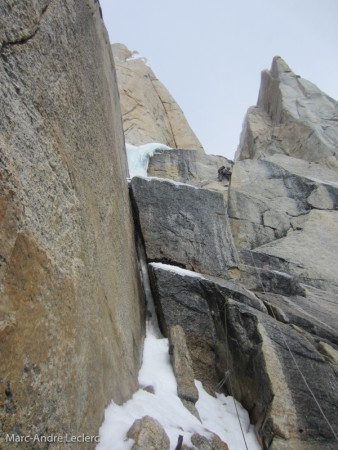





















8) Torre Egger Daytrip
After February 7th I had originally planned to team up with my friend Whit Magro, but he had to cancel. Alex Honnold and Tommy Caldwell planned to come down together in February as well, but Tommy also had to cancel. Without much fuss or planning, Alex and I teamed up. Alex and I had only previously roped up for one pitch together (on the NE Buttress of Mt. Slesse several years ago), so it was essentially another blind date. Alex is an incredibly talented climber in general, but has by far the least amount of alpine climbing experience of anyone I’ve climbed with in Patagonia, so I was curious what it would be like to climb together. Mostly I was worried that Alex’s standards of safety would be much lower than mine, but I was happy to discover that we weren’t so far off in our level of risk tolerance. I really enjoyed Alex’s company – He is interpreted by some as being cocky, but in fact I find him refreshingly honest and straightforward, without any false modesty (one extreme), spray (the other extreme) or other “tasty talking” (Marko Prezelj’s phrase).
Our first chance to climb together in the mountains came in mid February, in the form of a one-day window. On February 11 we hiked to Niponino, mulling over a few potential objectives, and decided on a one-day attempt of Torre Egger via the Standhardt ramps, Punta Herron and the Huber-Schnarf route (something which has been done 3 times before). On the 12th we leisurely hiked up to the Norwegos bivouac and went to bed early. On the 13th we left Norwegos at 3:30am, and starting tromping up glacier to the Standhardt Col. The short couloir leading up to the Standhardt Col was fairly melted out, and Alex, having only ever worn crampons before on a handful of days, was a bit stressed out by it. Nonetheless, he didn’t ask for a rope until the last little bit, and we gained the col relatively quickly. We simul-climbed the two mixed pitches above the col, and then a long easy section, leading to a short rappel below the Exocet chimney. After the short rappel, we had another long section of simul-climbing to the top of the ramp system on Standhardt’s east face. I was very impressed by Alex while on this section – We were certainly moving a bit slower than I would’ve been with one of my regular Chamonix partners, but not by much. The terrain is not difficult, but simul-climbing very exposed 50 and 60 degree snow and ice slopes, with often only one or two pieces of protection between us, is something that even experienced alpinists are often stressed out by.
From the top of the Standhardt ramp we made two long rappels into Tobogan, and then climbed one very easy ice pitch up to the base of Spigolo dei Bimbi. “Bimbi” is another route which I had jumared behind Rolo in awe in 2008, but hadn’t ever done the moves on. We put on our rock shoes, and it was Alex’s turn to lead. From the beginning of our planning for Torre Egger, Alex was adamant that we’d be simul-climbing the rock sections. I was apprehensive – Simul-climbing 5.10 is something that I sometimes do in Squamish or Yosemite, but here the rock was wet in spots, plastered with rime in other spots, and we each were carrying a pack with boots, crampons, tools, ice screws, food, water and clothing. To mitigate the potential danger of the follower falling while simul-climbing, we had brought two Petzl microtraxions, and the leader would put a microtraxion on a solid piece once every 60m. With this additional safety measure we started up, and to my surprise and delight, it went wonderfully, and we dispatched the rock of Spigolo dei Bimbi in two pitches. Above the rock, we again simul-climbed, climbing rime to the summit of Punta Herron in one pitch what would normally be three. I had to chuckle – Alex, having just pressured me into simul-climbing 5.10, was pretty freaked out following AI3!
We made one long rappel into the Col de Lux, and soon were starting up the Huber-Schnarf route on the north side of Torre Egger. Again we simul-climbed with microtraxions, climbing to the summit of Torre Egger in one pitch of rock followed by one pitch of ice. We were on the summit by 4:45pm, just over 13 hours after leaving Norwegos. I was amazed at how the simul-climbing had transformed our experience – It’s such a fast tactic compared to pitching out the climbing that we had made very good time, despite never feeling like we were rushing. Getting off of Torre Egger is a very long descent no matter which way you choose to go, but it helped that I had rappelled down from the Col de la Mentira just a couple weeks earlier. Our descent went as smoothly as a descent off of Torre Egger could be. We were back on the glacier right at dark, and back to our tent at Norwegos before midnight, roughly 20 hours after departing.









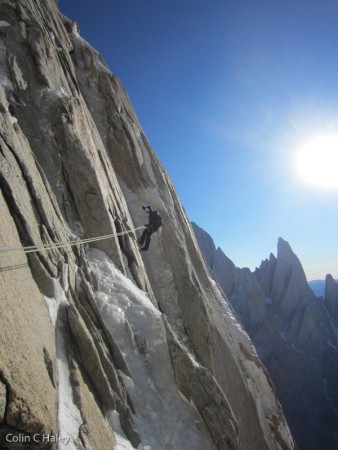





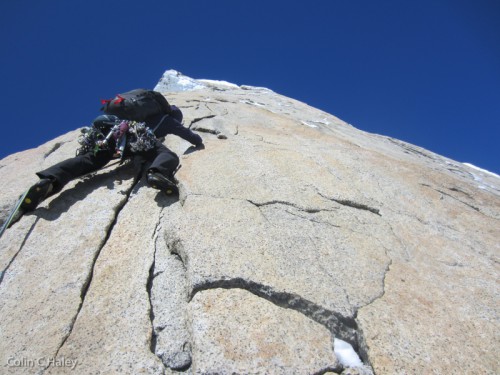




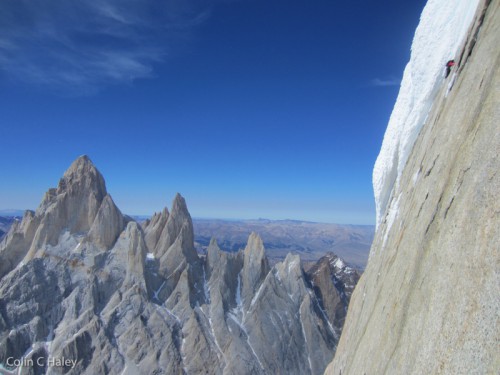








9) Torre Traverse Daytrip Attempt
Ever since Alex climbed the Fitz Traverse in February 2014 with Tommy Caldwell, he has had his eyes set on the Torre Traverse. Naturally, when we decided to climb together, this topic came up quickly. Since the Torre Traverse is something I had already climbed years earlier, I wasn’t interested in repeating it again unless I changed my experience on the climb significantly. I had always imagined that if I went to do the Torre Traverse again I would lead all the rock (the sections that Rolo led and I jumared in 2008), but it REALLY would not make sense for me to team up with Alex Honnold and lead all the rock, since he is an enormously better rock climber than me, and basically does not know how to ice climb at all. So I offered an alternate plan: How ‘bout trying the Torre Traverse without jumars? Alex was into the idea.
The yet much more ambitious idea came from Alex, and only the day after we had climbed Torre Egger. While hiking out he said, “Hey, What if we try the Torre Traverse single push?” Torre Egger had gone so easily that he figured the Torre Traverse should too. My initial reaction was definitely no: “Alex, That’s not realistic. Climbing Standhardt takes a lot more time and energy than just traversing across the side of it, and adding on the north face of Cerro Torre is a huge addition.” It only took about five minutes though for me to change my tune: “OK, I’m still not sure if that’s realistic, but that is such an awesome idea that I want to try it.” Launching across the 3.5 Torres with daypacks? The idea was VERY exciting. We talked strategy, and came up with as many concrete plans as we could for how to save time. This mostly applied to the terrain on Punta Herron and Torre Egger, which was fresh in our minds and easy to pick apart the same way a speed-climbing team would for a route on El Capitan. Mostly we hoped that we’d get a chance to try it. I got progressively more and more excited about the goal.
Another weather window showed up about a week after our Torre Egger climb, and Alex and I hiked back into Niponino on February 19. We followed my normal routine of taking a relaxing rest day on the 20th, just hiking from Niponino to a bivouac on the glacier below Cerro Torre’s east face. We knew we’d have to start super early, so we ate dinner and lay down to sleep in the early evening. Unfortunately, by about seven or eight in the evening it had started raining. Shit. I had already had my most successful climbing season ever, and could’ve easily gone straight home very content, but I had grown very excited about Alex’s idea and really wanted to try it. We dosed off, hoping we’d get our opportunity but no longer so sure. When our alarm went off at 1am it was still raining. Damn. We reset the alarm for 3am and went back to sleep. By 3am the rain had mostly ceased, with just a light mist coming down, and we decided to gear up. Conditions to head up on the Torres were far from inspiring, but having “Stinkfist” (a song by Tool) as your alarm clock certainly helps.
It was roughly 5am when we arrived at the Standhardt col and started up the Torre Traverse. We were enveloped in dense cloud, it was still misting on us, the snow was unfrozen mush, and the first pitch had streams of water pouring down it. It was the worst conditions in which I’ve ever embarked on a climb in Patagonia, and here we were thinking to try the Torre Traverse single push… It seemed to me that we were perhaps pushing logic too far to the side with our ambition, and I voiced my concerns to Alex. He cited Tommy’s motto of “We can always try, and climb until it gets too bad to keep going.” I gotta hand it to Alex – he’s fucking motivated! “All right, fuck it.” I thought. “We can always rap down Desarmada in a couple hours and lose relatively little.”
If you’re gonna start at all then you might as well try for real, and as soon as I started climbing I stopped thinking about the absurdity of our goal in these conditions. We only rejoined at one belay stance between the Standhardt Col and the first pitch of the Exocet chimney, and made great time. As we started up Exocet we began to poke out above a sea of clouds, and the sun rose as well. It was a mixed blessing: On one hand, it was encouraging to be climbing under clear blue skies and the views above the sea of clouds were incredible. On the other hand it made for horrendous conditions in the Exocet chimney – It had been under a barrage of sleet and very wet snow all night, socked in cloud so much that it never had a solid freeze, and then it went straight from socked in cloud to basking in strong morning sun on an east face. There was already water running down the ice on the first pitch, and the ice was the most rotten of any time I’ve climbed Exocet. In the interest of carrying only one pair of real ice tools, this was the one section of the Torre Traverse where we planned to not have the follower climbing. I short-fixed as fast as possible, occasionally hit Alex with a painful chunk of rotten ice, and Alex jugged with one Microtraxion and one “Basic” ascender (an imperfect jugging system, but one that is lightweight, since we did not plan to jug much). We were motivated to move fast both because it was necessary for our goal, but also because Exocet was melting as fast as we were climbing it. We made it through this gauntlet successfully, but by the top of the chimney both of my boots had become completely saturated – an unfortunate result that I would be suffering from for many hours to come.
From the top of the chimney we made another long simul-climbing pitch to Standhardt’s summit, arriving roughly 5.5 hours after leaving the Standhardt Col, at 10:30am. The rappels down the south face of Standhardt went smoothly, and by 12:30 we were starting up Spigolo dei Bimbi. Armed with better knowledge of the route, and in my case more confidence with our simul-climbing systems, we climbed to the end of the rock in one pitch. I led a simul-pitch up the remaining three ropelengths of rime, this time taking a slightly more efficient path, and arrived on the summit of Standhardt at 2:30pm. We made the rappel into the Col de Lux, and employing one of Alex’s speed tricks, I started scrambling up the lower Huber-Schnarf tied into the lead line at the same time that Alex was pulling the rap line through the rappel anchor. Alex started up the first 5th-class section of the Huber-Schnarf at 3:30pm. We again climbed the Huber-Schnarf with one simul-pitch up the rock and one simul-pitch up the rime, moving a bit faster than last time since we knew the way well. We arrived on the summit of Torre Egger around 4:45pm – The same time as during our previous outing, with roughly the same start time and another mountain climbed. Rappelling the south face of Torre Egger also went a bit faster, thanks to two rappel anchors I had placed during our previous outing.
We reached the Col de la Mentira at around 6:30pm, climbed one mixed pitch up to the base of Directa de la Mentira, and switched into rock shoes for the third time. Having just traversed 2.5 Torres in about 13 hours, we already felt plenty tired. Our feet hurt, my hands really hurt, the sun was going down, the wind was picking up, and we were starting up the north face of Cerro Torre, via a route which only a few weeks earlier had felt like a big deal in and of itself. In Alex’s words we just needed to “grind it out.” I had told Alex earlier that I didn’t think the first couple pitches of Directa de la Mentira were simul-climbing terrain. He disagreed until about 15m up the first pitch, upon encountering the first patch of verglas. The heavy rain the night before had wrecked havoc on climbing conditions on the north face of Cerro Torre. Spigolo dei Bimbi and the Huber-Schnarf seemed to have been spared (probably because of the lower altitude), but there was verglas all over the north face of Torre. From afar conditions had looked at least as good as during Marc and my ascent – On closer inspection conditions were much worse. Simul-climbing was momentarily forgotten as Alex french-freed up the first pitch, but he at least managed to link in one pitch the first two that Marc and I had climbed. Another linked pitch, this time with about 20m of simul-climbing, brought us to the top of Marc and my fourth pitch, and it was time for headlamps.
We were now climbing by headlamp, wearing all of our clothing, on significantly verglassed rock. The 180m pitches of Punta Herron and Torre Egger were no longer reasonable, but we still averaged about 80m per pitch. Every time I was anxious about leaving the belay simul-climbing, and every time I was relieved to find it reasonable, with a real belay already on by the time I was climbing the harder bits. Alex’s block up the north face of Cerro Torre at night was one of the most impressive lead blocks I’ve ever witnessed. With all the verglas the climbing felt downright hard in some places, but more significantly it’s simply a lot of terrain to cover, especially at night, especially in the wind, especially with a heavy pack, especially with numb fingers, and especially having already climbed three mountains. I realized on this block that Alex is one tough motherfucker. Us Alpinists often view rock climbers as athletically superior to us, but not as tough. I think it is often true, but Alex definitely defies it. Although his focus and forté is pure rock climbing, his mentality is definitely that of an alpinist.
Alex’s heroic lead block brought us up to the base of the last pitch on the north face, the rime/aid pitch. Here we switched back into boots – something that is normally a relief, but with my soaked boots was not much of one. As I lead the rimey aid pitch the wind gusts started growing to worrisome strength. Like on Exocet, Alex came up with our makeshift jugging system, and I took off on the rime above. We quickly climbed up two pitches of rime in a frenzy, excited to be finishing our goal. As I finished the second of these two pitches the wind gusts took on a much more sinister character. My body was getting blown around strongly enough that it was becoming difficult to climb even such easy terrain. At a protected belay stance where I had been planning to merely place a microtraxion and keep going, I stopped and brought Alex up to discuss our situation.
Alex came up to the protected belay nook, and we took stock. After roughly 21 hours of climbing, all that stood between us and the second ascent of the Torre Traverse was two pitches. The first one is dead easy, and almost completely inside of a tunnel, protected from the wind. The second pitch is the classic last pitch of the Ragni Route, historically quite difficult, but in very easy condition this past season (like in 2013 – about AI4+). In decent weather we’d be on the summit in no more than an hour, but at that moment we were nearly getting blown off our feet every time we poked out from the protected nook. Fuck, what to do? On one hand if we tried to continue we most likely would succeed in our awesome goal, and then rappel down the Southeast Ridge, straight back to our tent on the glacier. On the other hand, the wind was so strong that I think getting blown off the last pitch was a real risk, and although the pitch was in very easy condition it is still runout climbing. I remembered how hard the wind gusts had hit Marc and I at the top of that pitch, in much more benign wind than this. If I took a 30m fall and broke my legs on the last pitch of Cerro Torre, during the onset of a storm, I almost surely would die. If we didn’t continue we could either bail down the north face (as Marc and I descended), the most direct route back to civilization, or bail down the Ragni Route and commit to a very long wilderness march along the Hielo Continental (South Patagonian Iceap). When Marc and I had rappelled the north face in high wind it had felt very serious, and the wind this time was probably twice as strong. We both wanted very badly to finish our goal, but I also wanted very badly to survive, and there is always some point in alpine climbing when saying “let’s keep trying” is no longer about being very motivated, and instead about being foolish and dangerous.
Desperately wanting not to give up, we slumped down onto the belay anchor and hoped the wind would at some point lessen. We sat on our packs and hung in our harnesses on the 50-degree ice, huddling together for warmth. Alex said it was his first time cuddling with another man – I’m much more of an alpine slut than that. We spent somewhere between two and three hours hanging at this belay, hoping fiercly that we’d get an opportunity to finish the climb. I got up periodically to swing my legs. My toes were freezing in my soaking boots, and I was very worried about frostbite, something which is normally not a concern in Chalten summertime in Baturas. When the sky finally grew light we could see dark clouds in every direction, there was no sign of the wind abating, and we finally gave up our dream. In the weeks since I have of course thought many times about how things might have gone if I had never even paused at that belay stance, but once we decided to bail I simply wanted to survive. Poking our heads out from our protected nook we realized that in fact the wind had grown noticeably stronger. Conscious of the long march that I was getting us into, I insisted that we descend the Ragni Route. Our situation felt completely serious, and the Ragni Route is by far the easiest, shortest, fastest and simplest way off of Cerro Torre. We can survive walking for a long time, but rappelling the north face in those conditions would have been rolling the dice.
Alex had the great idea to simul-rappel. I’m normally not a big fan of simul-rappelling, but in these conditions it was very advantageous. The wind was blowing the ropes violently, and by simul-rappelling each of us only had to deal with 60 meters of rope, rather than the first person dealing with 120 meters. The Ragni Route is as easy as rappeling gets in Chalten, with straightforward rappels down ice from Abalokov anchors, but it felt very intense in such strong wind. We were getting blown around a lot, and a few times my strand of rope was almost completely devoid of tension as I was blown by an updraft.
We reached the glacier in the Circo de los Altares around noon on February 22nd, about 32.5 hours after leaving our tent below Cerro Torre’s east face. We could finally take off our helmets, loosen our boots and harnesses, and I ate my last 200 calories – the first snack I’d eaten since the end of Alex’s lead block on the north face. Thankfully it was warm enough to find some liquid water, as we hadn’t brought a stove. Without a stove, food or shelter, the Hielo Continental is not a place where a human can survive for very long, so despite our already significant fatigue we started into our soul-destroying march straight away. I’ve travelled between the Circo de los Altares and Paso Marconi a couple times before, but it never before felt remotely as long as it did this time. We started out fortunately on bare ice, but with a strong headwind. The headwind luckily abated, but soon we were breaking trail in boot-top soft snow. Alex played music from his iPhone until the battery died. Running very low on energy, we periodically stopped and lay down in the snow, getting up to move again when we would start to get cold. It snowed on and off.
Finally we reached Paso Marconi, and with painful knees and feet descended into the Marconi valley. We managed to finish the last descent off the Marconi Glacier just before dark. Fortunately I knew the Marconi valley approach well enough that we could pick our way along the path in the dark, amid very strong gusts of wind. We were both extremely tired, extremely hungry, and my feet were very painful and swollen from so many hours in saturated boots. We employed a tactic that I’ve learned from a few previous similar experiences – We would hike with all our clothing on to get nice and warm, and at the point when you would normally need to take off a layer we would simply lie down on the ground and fall asleep for a few minutes. After laying down for about fifteen minutes you start getting too cold to sleep, so you get up and start walking until you warm up again. It was comforting to return to a world where there are plants – an environment that feels much more survivable. Near the campsite known as “La Playita,” we stopped to lay down among a bunch of wild berries and I gorged myself. The last couple hours of hiking before Piedra del Fraile we gave up on any rest stops as slashing rain came down and soaked us completely. We finished our endurance trek early on February 23, pounding out the last kilometers of trail still in pouring rain, but in the hospitable environment of forest. Upon reaching the road we had a couple more painful kilometers to hosteria El Pilar, where finally we could call a taxi, sit down, and each drink a glass of orange juice kindly offered by Tomaso, which tasted like gold. We had been going for 53 hours, and for the last 35 hours I consumed only 200 calories.
The storm that hit Alex and I high on Cerro Torre came in a full 24 hours earlier than forecasted, and also much stronger than forecasted. Weather forecasts have greatly changed the experience of climbing in the Chalten Massif, but they’re still not foolproof. Our tent below the east face of Cerro Torre, anchored with 4 ski poles that each went a meter into the snow, was blown away without any trace other than the platform in the snow. Our tent down in Niponio, anchored with heavy granite rocks and in a protected nook, was blown a hundred meters before getting caught amongst some boulders, was completely destroyed (and nearly all of the contents blown away).
I wish badly that Alex and I had managed to finish our goal, and it definitely nags me that we didn’t. Part of me feels like we were “robbed,” since if the weather had held we would’ve made the second ascent of the Torre Traverse in a mere 22 hours. But of course weather is part of alpine climbing, and getting thwarted by weather and conditions is normal. It’s always easy to use the weather as an excuse. The truth is that if we had simply reached our highpoint 60 minutes earlier, then the wind would’ve still be reasonable enough that we would’ve pulled it off. In hindsight we could’ve very easily started one hour earlier, or even covered the same terrain one hour faster, but we thought we had an entire 24 hour buffer of good weather remaining. C’est la vie.
Despite failing, I am still very proud of our climb, and I think it is among my best climbing accomplishments. Alex was an outstanding partner, and our partnership was a very beneficial symbiosis – Alex wouldn’t have had a chance to climb the Torre Traverse without me to lead the way on the ice and mixed, and I would’ve never had a chance to climb the Torre Traverse in a day without Alex rope-gunning the rock. The key was simul-climbing all the rock-climbing, and that was only possible because Alex is so strong that he can run it out a long ways, even with a heavy pack, even on 5.10, even with verglas, even in the dark. If I were leading the rock I would’ve run out of protection much sooner, and the pitches would’ve been half as long. Regardless of the climbing significance of our “magnificent failure” (screw false modesty – I think the term is appropriate), it was an amazing experience, and certainly the most epic experience I’ve had in Patagonia. It blew my mind despite eleven previous trips to Chalten, so I can only assume it blew Alex’s as well.




















10) Torrisimo
After my attempt with Alex on the Torre Traverse I took a couple much-needed rest days in town. Alex flew home, and one more half-day window appeared. I needed to head back into the Torre Valley, to clean up and collect what was left of the two tents that were destroyed. With less than a full day of good weather forecasted, I decided the most exciting objective for the time constraints would be Torrisimo. Torrisimo is a small but very slender spire on the ridge between Torre de la Medialuna and Punta Pereyra, named by Silvo Karo during his and Andrej Grmovšek’s badass Cerro Torre sit start. Like many things in the Chalten Massif, despite being visually very appealing, it remained unclimbed. I asked Jon Schaffer, a mellow and motivated climber from Colorado, on his third trip to Chalten, if he’d like to join me.
Jon and I hiked from town to Norwegos on February 26, and the following morning made the short approach to the north side of the ridge on which Torrisimo is located. We choose the easiest-looking crack system, and climbed two pitches of 5.9-5.10, followed by a section of 3rd and 4th class scrambling, to the base of Torrisimo. Torrisimo looked like it could be climbed by at least a couple different crack systems, but we chose a crack on the southwest arête. From the base of Torrisimo to the top was just one pitch, about 50 meters long. I climbed it at about 5.9 C1, although after some traffic (the rock was flaky) it would probably make an enjoyable pitch of 5.11. We rappelled off the summit from a natural granite thread, and then lower down from pins and a stopper to return to our boots. Our climb was nothing extreme, but a nice day out with a friendly partner, and the first ascent of a cool little tower. We hiked out to town that evening, arriving at midnight, and about twelve hours later (after a frantic, last-minute packing session, with some help from Rolo) I was on a shuttle departing Chalten, concluding the most successful climbing trip of my life.








